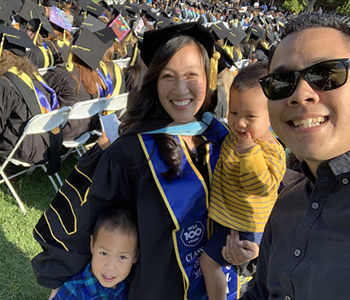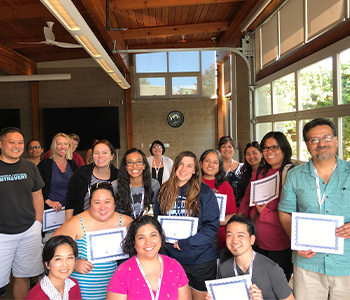Taking on Climate Change with Courage
By Dr. Kelley T. Le
I remember the day I was invited to attend a group meeting with Dr. Deborah Ball to learn more about discretionary spaces and how these small interactions carry such great weight in classrooms. I was so excited to chat more with her about teacher support and how her research opens up the conversation to equity for justice work. Everything took a turn for me during our meeting, however, when Dr. Ball initiated the conversation with a simple question. She asked the group, “What keeps you up at night?” You see, the night before meeting her I came across an article that shared climate models so bleak that scientists predict half of all saltwater fish dying off in our lifetimes if we don’t take action to bend the curve now. In truth, what keeps me up at night is thinking about the climate crisis and how my kids (and all kids) will inherit the unjust challenges ahead. So while everyone began sharing more about their work in education, I felt paralyzed that all I could think about was whether or not people will have access to basic human rights such as clean air, water, land, or food due to climate change.

Although I am not a climate scientist, my educational training and dissertation work through UCLA Center X, allowed me to leverage my strengths as a teacher leader, program designer, and instructional coach to support drawdown efforts through education. My former professor, Dr. Tyrone Howard, recently shared that we should stop using the word “resilient” when we describe young people who “make it” through the educational system. To be resilient is to do so in the face of trauma and that should not be normalized or glorified for students. Unfortunately/fortunately (depending on how you see it), I am one of those resilient students. I am a First Generation, Southeast Asian student of color who grew up in the inner cities of Los Angeles. My class statistics tell me that I am 1 out of 4 students who went directly to a 4-year university and successfully graduated (we started with nearly 1000 students at my Title 1 school). My mother emigrated from Viet Nam as a teenager to seek refuge from the war, and ended up raising the three of us on her own. She started as a sweatshop factory worker in downtown L.A., and now currently works for NASA and Boeing. I come from a long line of resilient people. Knowing this, in the face of these terrifying climate models and projections, I was always going to find ways to be part of the solution on this urgent and overwhelming issue.

applications of nanoscience and nanotechnology.
My actions started in the classroom by integrating climate science into my high school chemistry and nanoscience classes to fulfill the NGSS. I learned that students are most engaged (and enraged) when they learn about the climate crisis. Often, they are angry that they didn’t learn about this sooner, but then they learn to redirect that energy into thinking about how we can use this knowledge to demand and design better solutions. Students engaged in deep conversations about the ethical and social dimensions related to climate change policies, began to ask more complex questions about potential solutions, and started to see how this context provided deeper meaning and application for the science content. NGSS stresses the importance of positioning students as capable contributors and do-ers of science and engineering - teaching them about climate change gave them meaningful and relevant ways to engage.
From that point, I decided to put my dissertation research into practice and connect with field experts and educational leaders to help me design a climate change educational program for teachers that successfully leverages the NGSS. Wanting to support as many teachers as possible, I decided to write a book to share all that I have learned on how to teach about the climate crisis in ways that will activate student agency. In my upcoming book, Teaching Climate Change for Grades 6–12: Empowering Science Teachers to Take on the Climate Crisis Through NGSS (Routledge, 2021), I support educators in thinking through what using climate change as anchoring content should look, feel, and sound like. The book is a culmination of information shared with me from over 50 local environmental organizations to learn about the impacts of climate change, and big ideas of climate science from national educational directors and scientists.

multi-day climate change education program at Heal the Bay.
In going through this process, I have learned a great deal about what works with teachers and about what doesn’t support them with classroom enactment of professional development material. It always came back to teachers’ underlying values and beliefs about science teaching, learning, and students (and how those are also influenced by culture, identity, implicit biases, personal experiences, views of schooling, and so on). So as we think about ways to support educators in taking on climate science, we have to reflect on what the vision of science education is and what it can be alongside teachers. Are all students seen, heard, and valued in the classroom? Are they positioned to apply the science to their lived realities to improve the lives of people? Are they learning 21st century skills and knowledge to address the problems of today? Students are already leading the way on climate change efforts and they deserve to learn the science of climate change. Together, we can provide meaningful science instruction through transformative learning experiences to support students as capable change agents.

education program at Aquarium of the Pacific.
Climate change is the most urgent and pressing issue of our time and the future they warn us about is already here. As explosive wildfires ravage states, prolific hurricanes wipe away entire cities, ocean acidification is threatening the food supply of almost 1 billion people, the melting permafrost is causing sea level rise and coastal erosion, deforestation is impacting whole ecosystems and unleashing harmful viruses and diseases, and so much more (IPCC, 2018). We must believe that our students are capable agents of change that can and will rally the support needed to bend the curve. We need to teach them about climate change and beyond one class period. This complex and intersectional problem will require that we all work together to think through meaningful solutions. So while I stay up late at night thinking through what I can continue doing to help educators use their platform with students to bend the curve, I know I am part of a larger movement of people advocating for a brighter and more sustainable future.
Dr. Kelley Le has been in the educational field for over a decade as a high school science educator, instructional coach, and educational leader. She is currently leading the UCI Science Project to support K-12 science educators and leaders.






